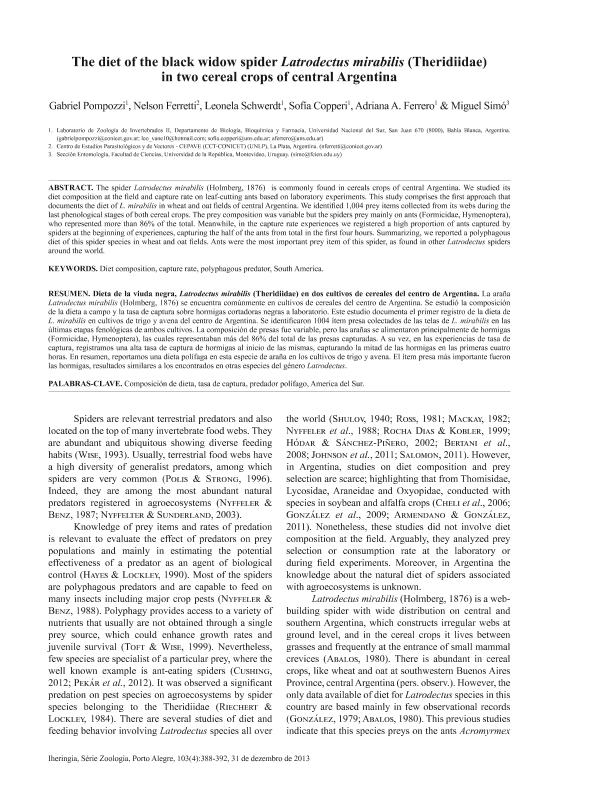Mostrar el registro sencillo del ítem
dc.contributor.author
Pompozzi, Gabriel Alejandro

dc.contributor.author
Ferretti, Nelson Edgardo

dc.contributor.author
Schwerdt, Leonela Vanesa

dc.contributor.author
Copperi, Maria Sofia

dc.contributor.author
Ferrero, Adriana Alicia

dc.contributor.author
Simó Núñez, Miguel

dc.date.available
2015-09-25T20:00:10Z
dc.date.issued
2013-12-31
dc.identifier.citation
Pompozzi, Gabriel Alejandro; Ferretti, Nelson Edgardo; Schwerdt, Leonela Vanesa; Copperi, Maria Sofia; Ferrero, Adriana Alicia; et al.; The diet of the black widow spider Latrodectus mirabilis (Theridiidae) in two cereal crops of central Argentina; Fundaçao Zoobotanica Rio Grande Sul; Iheringia. Série Zoologia; 103; 4; 31-12-2013; 388-392
dc.identifier.issn
0073-4721
dc.identifier.uri
http://hdl.handle.net/11336/2154
dc.description.abstract
La araña Latrodectus mirabilis (Holmberg, 1876) se encuentra comúnmente en cultivos de cereales del centro de Argentina. Se estudió la composición de la dieta a campo y la tasa de captura sobre hormigas cortadoras negras a laboratorio. Este estudio documenta el primer registro de la dieta de L. mirabilis en cultivos de trigo y avena del centro de Argentina. Se identificaron 1004 ítem presa colectados de las telas de L. mirabilis en las últimas etapas fenológicas de ambos cultivos. La composición de presas fue variable, pero las arañas se alimentaron principalmente de hormigas (Formicidae, Hymenoptera), las cuales representaban más del 86% del total de las presas capturadas. A su vez, en las experiencias de tasa de captura, registramos una alta tasa de captura de hormigas al inicio de las mismas, capturando la mitad de las hormigas en las primeras cuatro horas. En resumen, reportamos una dieta polífaga en esta especie de araña en los cultivos de trigo y avena. El ítem presa más importante fueron las hormigas, resultados similares a los encontrados en otras especies del género Latrodectus.
dc.description.abstract
The spider Latrodectus mirabilis (Theridiidae) is commonly found in cereals crops of central Argentina. We studied its diet composition at the field and capture rate on leaf-cutting ants based on laboratory experiments. This study comprises the first approach that documents the diet of L. mirabilis in wheat and oat fields of central Argentina. We identified 1004 prey items collected from its webs during the last phenological stages of both cereal crops. The prey composition was variable but the spiders prey mainly on ants (Formicidae, Hymenoptera), who represented more than 86% of the total. Meanwhile, in the capture rate experiences we registered a high proportion of ants captured by spiders at the beginning of experiences, capturing the half of the ants from total in the first four hours. Summarizing, we reported a polyphagous diet of this spider species in wheat and oat fields. Ants were the most important prey item of this spider, as found in other Latrodectus spiders around the world.
dc.format
application/pdf
dc.language.iso
eng
dc.publisher
Fundaçao Zoobotanica Rio Grande Sul

dc.rights
info:eu-repo/semantics/openAccess
dc.rights.uri
https://creativecommons.org/licenses/by-nc-sa/2.5/ar/
dc.subject
CAPTURE RATE
dc.subject
DIET COMPOSITION
dc.subject
POLYPHAGOUS PREDATOR
dc.subject
SOUTH AMERICA
dc.subject.classification
Zoología, Ornitología, Entomología, Etología

dc.subject.classification
Ciencias Biológicas

dc.subject.classification
CIENCIAS NATURALES Y EXACTAS

dc.title
The diet of the black widow spider Latrodectus mirabilis (Theridiidae) in two cereal crops of central Argentina
dc.title
Dieta de la viuda negra, Latrodectus mirabilis (Theridiidae) en dos cultivos de cereales del centro de Argentina
dc.type
info:eu-repo/semantics/article
dc.type
info:ar-repo/semantics/artículo
dc.type
info:eu-repo/semantics/publishedVersion
dc.date.updated
2016-03-30 10:35:44.97925-03
dc.identifier.eissn
1678-4766
dc.journal.volume
103
dc.journal.number
4
dc.journal.pagination
388-392
dc.journal.pais
Brasil

dc.journal.ciudad
Porto Alegre
dc.description.fil
Fil: Pompozzi, Gabriel Alejandro. Universidad Nacional del Sur. Departamento de Biología, Bioquímica y Farmacia. Laboratorio de Zoología de Invertebrados Ii; Argentina
dc.description.fil
Fil: Ferretti, Nelson Edgardo. Consejo Nacional de Investigaciones Científicas y Técnicas. Centro Científico Tecnológico La Plata. Centro de Estudios Parasitológicos y de Vectores (i); Argentina
dc.description.fil
Fil: Schwerdt, Leonela Vanesa. Universidad Nacional del Sur. Departamento de Biología, Bioquímica y Farmacia. Laboratorio de Zoología de Invertebrados Ii; Argentina. Consejo Nacional de Investigaciones Científicas y Técnicas. Centro Científico Tecnológico Bahía Blanca. Centro de Recursos Naturales Renovables de la Zona Semiárida(i); Argentina
dc.description.fil
Fil: Copperi, Maria Sofia. Universidad Nacional del Sur. Departamento de Biología, Bioquímica y Farmacia. Laboratorio de Zoología de Invertebrados Ii; Argentina
dc.description.fil
Fil: Ferrero, Adriana Alicia. Universidad Nacional del Sur. Departamento de Biología, Bioquímica y Farmacia. Laboratorio de Zoología de Invertebrados Ii; Argentina
dc.description.fil
Fil: Simó Núñez, Miguel. Universidad de la República; Uruguay
dc.journal.title
Iheringia. Série Zoologia

dc.relation.alternativeid
info:eu-repo/semantics/altIdentifier/doi/http://dx.doi.org/10.1590/S0073-47212013000400009
dc.relation.alternativeid
info:eu-repo/semantics/altIdentifier/url/http://www.scielo.br/scielo.php?pid=S0073-47212013000400009&script=sci_arttext
Archivos asociados
